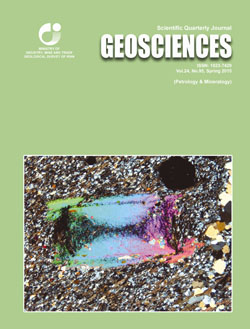Document Type : Original Research Paper
Authors
1 Ph.D, Department of Geology, Faculty of Sciences, Sistan & Baluchestan University, Zahedan, Iran
2 Associate Professor, Department of Geology, Faculty of Sciences, Sistan & Baluchestan University, Zahedan, Iran
Abstract
The Panah-Kuh skarn is situated in 50km NW of Taft City in Yazd province. Inrtusion of granodioritic stock into the calcareous-dolomitic rocks of Permian Jamal Formation led to formation of calcic and magnesian skarns. The REE patterns of skarns and its forming garnets show Eu/Eu* and Ce/Ce*ratios increase with increasing of ∑REE, implying that skarn forming fluids were dominantly of magmatic origin, whereas (Pr/Yb)cn ratio decrease almost with increasing of ∑REE that implying the magmatic fluids granitoid-derived had not much REE during the Panah-Kuh skarn formation. Based on the fluid inclusion data from garnet, fluid temperature and salinity in the prograde stage vary between 308-380oC and 12.6-23.8 wt.% NaCl equivalent, respectively. Inclusion fluids in the calcite had lower temperature (T<280°C) and fluid salinity decline to 3.5 wt.% NaCl equivalent. Mixing and dilution of early magmatic fluids with external fluids (e.g., meteoric waters) caused a decrease in fluid temperature and salinity in latest stage of the skarn formation. Therefore, both REEs and fluid inclusions data suggest the dominant role of magmatic water in the formation of Panah-Kuh skarn.
Keywords

